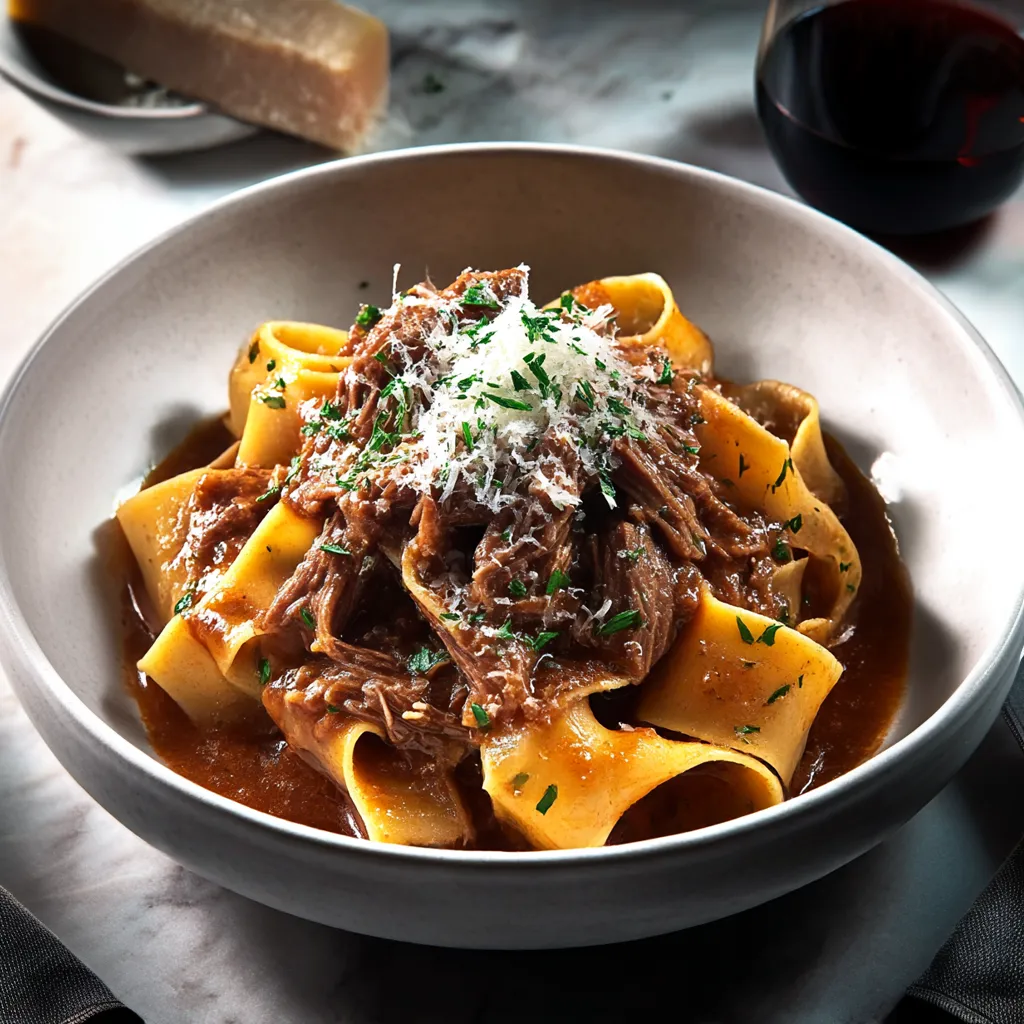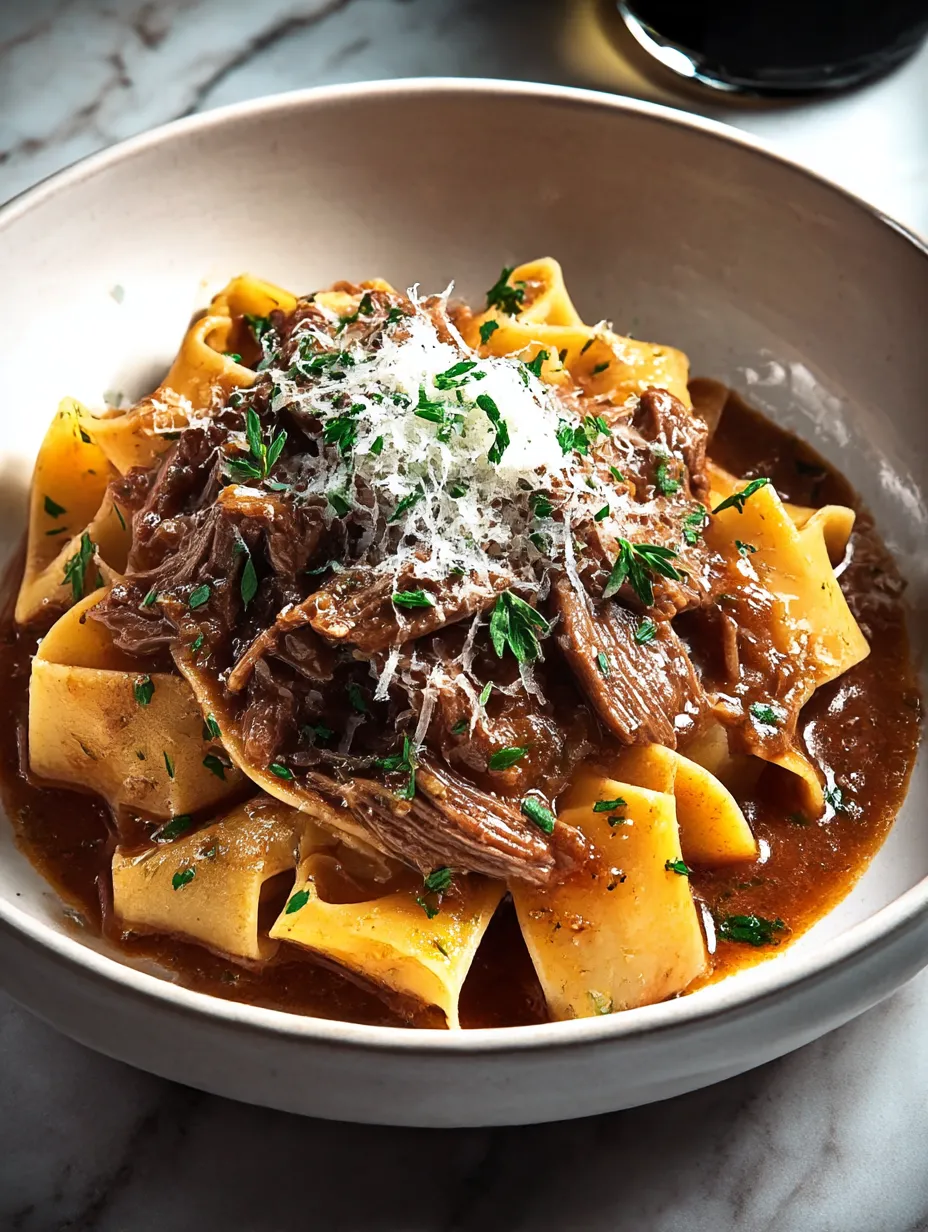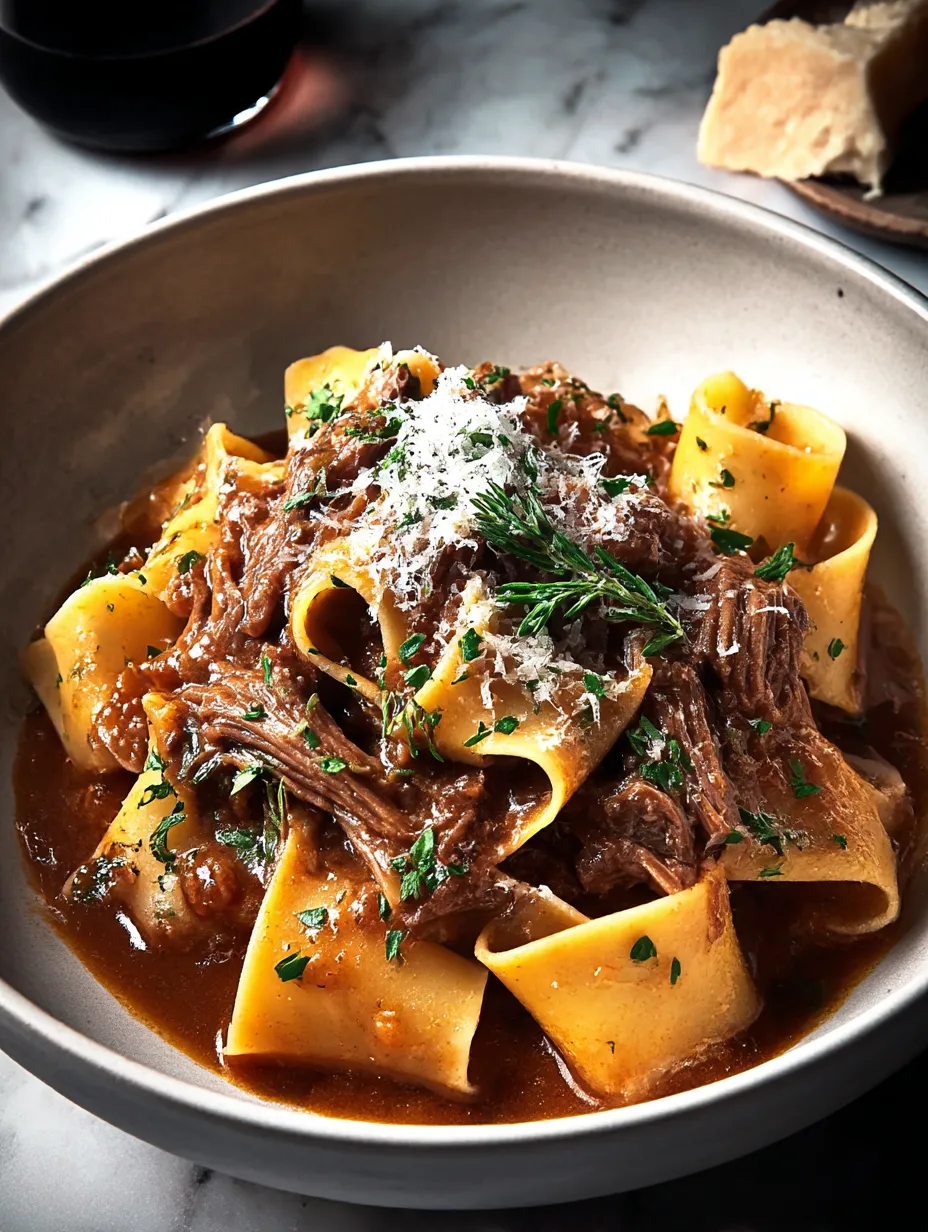 Pin it
Pin it
This slow-cooked beef ragu with pappardelle turns basic ingredients into an amazing dinner through patient cooking. The fall-apart beef chunks in thick tomato sauce paired with wide pappardelle pasta make a fancy restaurant-style dish right in your own kitchen.
I whipped up this ragu during a freezing winter weekend when I wanted something cozy yet impressive for some friends coming over. My house smelled amazing for hours while it cooked, and my buddies still mention it as the tastiest pasta they've ever tried.
Ingredients
- Beef chuck roast 2 pounds: This cut becomes incredibly tender after slow cooking. Try to get pieces with good fat marbling for richer taste
- Olive oil 3 tablespoons: Pick a nice extra virgin olive oil for browning to build deeper flavor
- Onion, carrots, and celery: This veggie trio builds your flavor base. Chop them small for the smoothest sauce texture
- Garlic 4 cloves: Brings wonderful aroma. Always go with fresh instead of the jarred stuff
- Crushed tomatoes 28 oz can: Makes the sauce body. Splurge on San Marzano tomatoes if you can
- Beef broth 2 cups: Boosts meaty taste and gets the texture just right. Go for low-sodium if you can find it
- Tomato paste 2 tablespoons: Deepens tomato flavor and helps thicken things up. Cook it a bit first to get rid of the raw taste
- Dried herbs (oregano and thyme): Add classic Italian notes. Rub them between your fingers to wake up their oils
- Bay leaves 2: Give subtle background flavor. Don't forget to take them out before eating
- Pappardelle pasta 1 pound: These broad noodles catch the chunky sauce perfectly. Fresh is awesome but dried works fine too
Step-by-Step Instructions
- Sear the Beef:
- Sprinkle beef chunks well with salt and pepper. Get olive oil hot in a Dutch oven until it shimmers then add beef in small batches so they don't crowd each other. Let each chunk get really brown before flipping, about 3 minutes per side. This step kicks off all the good flavor for your dish. Put browned meat on a plate and keep going with the rest.
- Develop the Flavor Base:
- Pour remaining oil in the same pot and throw in the onion, carrot, and celery mix. Cook at medium heat for 7 minutes, stirring now and then until veggies get soft and slightly browned. All those tasty bits from the beef will mix into your veggies creating amazing flavor.
- Build the Sauce:
- Toss in garlic and stir constantly for about a minute until it smells good but doesn't burn. Add tomato paste and keep stirring for 3 minutes. This cooks off the metallic taste. Pour in your crushed tomatoes and beef broth while scraping the pot bottom to get all those flavor bits loose. Toss in herbs and put the beef back in with any juices that leaked out.
- Slow Simmer:
- Bring everything to a gentle bubble then turn heat down to keep it barely simmering. Half-cover the pot so some steam escapes and flavors get stronger. Let it cook without bothering it for 2 to 2.5 hours, checking once in a while to make sure it's not boiling too hard. The beef is done when you can easily pull it apart with a fork.
- Transform the Beef:
- Take beef pieces out to a cutting board. Use two forks to pull the meat into small shreds, making sure to throw away any fatty or tough bits. Put the shredded beef back into the sauce and cook 10 more minutes so the meat soaks up all the sauce flavors. Taste it and add more salt or pepper if needed.
- Cook the Pasta:
- Get a big pot of water boiling hard and throw in enough salt that it tastes like seawater. Add pappardelle and cook until it still has a little bite, 1 minute less than what the package says. Save a cup of the starchy pasta water before draining.
- Marry Pasta and Sauce:
- Put drained pasta right into the ragu with a splash of that saved pasta water. Gently toss it all together for 1 to 2 minutes so the pasta absorbs some sauce. The starchy water helps sauce stick to every bit of pasta and makes everything silky smooth.
 Pin it
Pin it
Chuck roast really makes this dish special. I learned about its magic when I first tried slow cooking years ago. It starts out tough but after hours of gentle heat, something amazing happens. My family now knows exactly what's cooking just from the smell when they walk in on ragu day.
Storing and Reheating
This ragu actually gets tastier over time as flavors blend together. Keep sauce separate from pasta in a sealed container in the fridge for up to 4 days. When you warm it up, add a little beef broth or water since it thickens a lot while cold. Heat it slowly on medium-low heat and stir once in a while so it doesn't stick and burn.
Variations to Try
You can easily change this recipe based on what you've got handy. Try swapping out 1/2 cup of beef broth with dry red wine for extra flavor depth. For a creamier version, stir in 2 tablespoons of butter when you put the shredded beef back in the sauce. If you're in a rush, you can swap chuck roast with beef short ribs or even ground beef, though you'll get a different texture.
Serving Suggestions
This rich ragu goes great with a simple arugula salad with just lemon juice and olive oil, the brightness cuts through the hearty dish. Don't forget a chunk of crusty Italian bread to soak up every bit of sauce. For drinks, go with a medium-bodied red like Chianti or Montepulciano d'Abruzzo that can stand up to the big flavors without taking over.
Historical Context
Ragu comes from Northern Italy where folks learned to slow cook meat with veggies and tomatoes to make something special from basic ingredients. Traditionally left to simmer all day on a back burner, this dish shows how Italians turn simple food into something amazing through time and technique. Real Italian versions might use fewer tomatoes than we do here, but the idea of tender meat in a tasty sauce stays true to the original concept.
 Pin it
Pin it
Frequently Asked Questions
- → Can I prepare it in advance?
Definitely! It actually tastes better the next day. Keep it in a sealed container in the fridge for up to 3 days. Warm it gently before eating.
- → Is there another beef option?
For sure. Brisket or short ribs are great alternatives to chuck roast, offering the same juicy tenderness when slow-cooked.
- → Can the sauce be frozen?
Yes! Freeze the cooled sauce in a sturdy container, and it will stay good for 3 months. Thaw in the fridge overnight before reheating.
- → What can I use instead of pappardelle?
If you don't have pappardelle, tagliatelle or fettuccine are great stand-ins. Their wide shapes hold the sauce just as well.
- → Can I skip the cheese for a dairy-free option?
Sure thing! Just leave out the Parmesan and finish with fresh herbs for a simple, dairy-free alternative.
